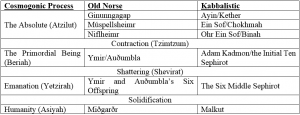Recently I found myself idly returning to an old suggestion: fitting Old Norse cosmogony into a Kabbalistic template. Both have similar emanatory passages, although as Kabbalists vociferously used the written word to transmit, formulate, and arguably consciously create their mythology, they had similarly detailed personal redemptive paths, something which Old Norse mythology has not preserved to such an extent. Accordingly, this aspect has been left absent.
In under a thousand words, this is obviously not a detailed interpretation. It is also worth clarifying that the Lurianic Kabbalistic template I have adopted here is predominantly derived from Aryeh Kaplan’s Inner Space – which serves as an excellent introduction to Kabbalistic concepts – and, to a lesser extent, Sanford Drob’s Kabbalah and Postmodernism.
The Absolute
The Old Norse cosmogonic narrative begins with Ginnungagap which is not simply a barren emptiness – although it is exactly this on one level – but also a creative absence. It is this willing aspect of the absence that allows the opposing elements of fire from Múspellsheimr and ice from Niflheimr to interact. In this context, Múspellsheimr represents the infinity of possibility, while Niflheimr represents a desire for singularity. Evidently, this is a paradox, but a necessary one as neither can be comprehensible without the concept of the other. This paradox is facilitated by the inherent contractive emptiness of Ginungagap, which causes an interaction that is characterised by the fire of Múspellsheimr acting as a volitional agent that melts the monolithic rime of Niflheimr. Accordingly, this effortlessly germinates Ymir, the hermaphroditic primordial being, who is stated to have simply “fallen into place” – the perfect actualisation of a latent potentiality.
As the primordial abyss, Ginnungagap corresponds quite well to Ayin, but also with the sephira Kether as the creative absence that wills and facilitates interaction. An excellent symbol for this is the space necessary for atomic reactions to occur. Accordingly, the fire of Múspellsheimr and the ice of Niflheimr correspond with Ein Sof and Ohr Ein Sof, infinity and the singular light that fills the infinity. In this sense they also correspond to the sephirot Chokhmah and Binah, gnosis and understanding respectively – the former is infinite, the latter isolates to classify finitely.
The Primordial Being
Ymir’s existence is sustained by the milk of Auðumbla, the primordial aurochs, who seems to spontaneously represent the fecundity of the aforementioned interaction between Múspellsheimr and Niflheimr. Auðumbla, for her part, subsides by licking salt from blocks of rime, by which she sculpts Búri, the first “man” and grandfather of Óðinn, Vili and Vé. This demonstrates a definite emphasis on masculinity and external creation using water, especially when Óðinn and his compatriots’ later creation of Askr and Embla is taken into account. For its part, Ymir also creates three beings: a man and a woman from its armpits, and a six-headed being from its legs. In contrast, this reproduction is internal – or, at least, suggests an asexual mitosis – and seems to represent equality within plurality, the offspring being male, female and indeterminately non-human.
As primordial beings Ymir and Adam Kadmon also correspond quite well, particularly as they are both torn apart to create the cosmos which they both essentially mediate: Adam Kadmon by supervising the filling of the sephirot; and Ymir and Auðumbla’s symbiotic creation of further beings. The major difference is that, in terms of the surviving mythology, Ymir could not be described as a proposed divine correspondent of humanity as this role is subverted by the Æsir and Vanir.
Emanation
The essentiality of Ymir and Auðumbla’s creation is a cancerous ‘overfilling’ of this contracted primordial space – as the aforementioned perfect actualisation of a latent potentiality – that tears its unity and disperses it throughout a cosmos created by the influences of their six offspring. The last aspect is humanity, as created by Óðinn and his compatriots, which solidifies the physical world, at least according to humanity’s initial perception.
Critically, there is a symmetry between the overfilling of the six middle sephirot that causes the shevirat (shattering) and the six beings that Ymir and Auðumbla create. At this stage of both cosmogonies, these six sephirot and beings are the first that represent any personal, human characteristics.
Conclusion
In summary, I hope this has post presented a relatively clear skeleton of a comparative study between Old Norse and Kabbalistic cosmogonies. The following table summarises the comparison described above.
One could, of course, create linkages between the six middle sephirot and Ymir and Auðumbla’s six offspring (which could also be linked to the remaining six Old Norse worlds), yet this is outside the scope of this post and would increase its length many times over. Furthermore, although the roles and identities of Óðinn, Vili and Vé have been analysed in numerous places, the roles and identities of Ymir’s offspring have generally been ignored. One exception to this is Vexior’s (a.k.a. Ekortu) Gullveigarbók which, while not strictly academic, does raise some interesting points.

